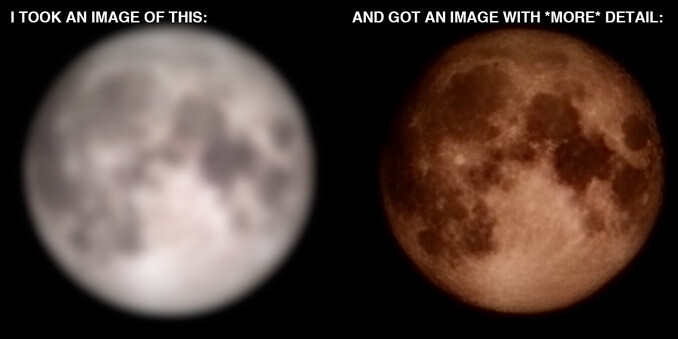Reddit user ibreakphotos discovers that Samsung's 'Space Zoom' simply replaces user's moon photos with higher-res images of the moon through a clever testing process.
https://www.reddit.com/r/Android/comments/11nzrb0/samsung_space_zoom_moon_shots_are_fake_and_here/
This isn't computational photography — it's inserting imagery that simply isn't there.
@halide it _is_ there though. The phone just isn’t able to capture it.
Why should my photos that include the moon not look like what I was seeing when took the picture?
@sdw @halide if it knew what my kids eyes looked like, probably. I’m just taking a picture of the moon though, so doesn’t have the same sentimental value to me as my kids eyes. I wish the camera sensor could capture what I saw better, but this seems like a decent workaround for now.
I can’t agree with the this-is-fake response since all photos are fake compared to what _I_ saw anyways. We need brain sensors for that
I just want a picture of how I saw something. And the moon had texture.
@sdw @halide hehe certainly an unpopular opinion judging by all the comments
But can we get closer to a technical explanation of the different type of enhanced photography we’re seeing these days? Computational photography, super resolution, machine learning. I’m not sure I see a red line of what is ok or not.
I do see a conservative “real photography” group with gate keeping and other stuff when technology and culture moves forward/on with their definition of red line changing over time.
@tobiasdm @sdw @halide
I think what Samsung does is much closer to image generation than photography. It is quite similar to something like Dall-E (but smaller in scale due to the narrower use case), with the difference that instead of writing a prompt like "Photo of the moon with a crater of the right and top right and some dark spots close to the center" you give it a low resolution photo containing the same information and the NN produces a picture.
@tobiasdm @sdw @halide I find this is highly deceptive. It gives a false idea of what technology can do and at the same time it gives a dangerous precedent of personal computers replacing reality with simulation with zero transparency.
I wouldn't wanna put this sort of a "Santa Claus" inside the tech my children get familiar with. I would want my children to grow up with a grasp on what's going on.
@sdw @tobiasdm @halide It's important that we continually draw attention to this kind of garbage faking "photographs", because these "photographs" will end up getting entered into evidence in trials and sending someone to jail based on something some AI bro's creation pulled out of its ass. Maybe it won't be the moon that does that, but the sooner the public starts to understand the scope of the fakery, the better.
@sdw is it tough?
This looks like aggressive image sharpening on the blurred image and whatever noise the camera chip introduces.
To test for pre stored detail you'd have to use an image of a cratory white object that isn't the moon and see if a moon is being put on top of it.
@betalars @sdw The picture on the left is a 170x170 pixel photo of the moon that was blurred, then blown up and shown on a computer screen, which was then photographed with the phone – resulting in the right picture. There is no mathematically possible way to get the detail on the right from just the picture on the left.
@chrisk okay the last edit had me convinced, I didn't read as much.
@tobiasdm @halide No, the picture on the left is of a computer monitor in a dark room showing a full-screen image that was digitally blurred. That is, this is not a photo of the moon, it is a photo of a badly blurred image of the moon. The detail on the right is fabricated and does not match what you would've been seeing in person.
@tobiasdm it literally is not there in this example. And they're lying about what the "camera" is doing



